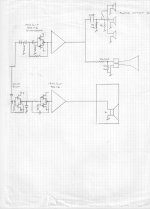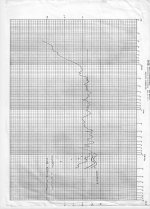Waly, do the math. It doesn't necessarily have to be 10 ohms, but there are 4 in parallel, making 2.5 ohms added noise.
Thank you.
and thank you for the info on the M2.
-Richard
I'm sure you'll be happy with Damier's CFA amps, very much in the same vein as O'stripper was going on his thread. I'll be interested in how you feel about changing from a the ESL type of sound and dispersion to a two way with horn, a fairly dramatic change to say the least. You could always put the 15" drivers you have to use as distributed subs in new enclosures spread around the room.
Hi,
I have always been a supporter of controlled dispersion to a more narrow angle. That comes from acoustic study and using horns (JBL) in the past. So now it is full circle but this time all is much better and the DSP will be a plus IMO.
I have measured and listened to Damir's CFA amp and it is the best amp I ever had in my system. Extreamly clear and clean.
THx-RNMarsh
You can thank Charles Sprinkle for the wide dispersion of the M2 HF driver. He is the reason the imaging of the M2 holds up off axis.
Get me the 'perfect' op amp, and I will use it!
Why such an obsession with perfection in the audio gear when at the end of the chain you're dealing with the embarrassingly imperfect human ear/brain system?
se
You can thank Charles Sprinkle for the wide dispersion of the M2 HF driver. He is the reason the imaging of the M2 holds up off axis.

I once made a design similar to the M2 in the mid 1970's, but a 3 way with an 800Hz and 10KHz active Xover. It measured OK, but it didn't sound right, so I gave up on speaker design. '-(
Attachments
Last edited:
because the imperfect brains are connected to hands that sign checks?

se
I once made a design similar to the M2 in the mid 1970's, but a 3 way with an 800Hz and 10KHz active Xover. It measured OK, but it didn't sound right, so I gave up on speaker design. '-(
That sounds like a recipe for failure... and I'm not a speaker designer!
But how many guys at great at electronics and speakers at the same time?
It's just too bad the design team didn't use Patent 7711134 on the M2 bass porting. But that would have meant tipping a hat to a foe in the war that was forced upon the Multimedia department when they were forced into the consumer group proper. That was something to behold: The dumbing down of a whole group of really smart innovators.
Last edited:
John that wouldn't happen to be a three way enclosure that was a John Meyer enclosure would it? Had a 15" a 1.4" Altec and a bullet tweeter. The mid horn was mounted in the center of the bass horn and the bullets I think were off to the sides. Was that your idea?
morinix,
It isn't like there was anything new in that patent, been done before for sure. A horn flare for a port goes back so far it would probably be in some early Webster papers. No real advantage over a flared port opening.
It isn't like there was anything new in that patent, been done before for sure. A horn flare for a port goes back so far it would probably be in some early Webster papers. No real advantage over a flared port opening.
No, the loudspeaker that John Meyer and I worked on was a 3 way horn loaded speaker with 3 separate amps (JC-3 for the tweeter) and a transient 'perfect' xover. We used a time delay for the tweeter (Electrovoice T350).
This design was separate from the one that John Meyer that I worked on in Switzerland, and started after he returned to the USA.
This design was separate from the one that John Meyer that I worked on in Switzerland, and started after he returned to the USA.
They had a program to make sure the port noise was at a minimum. I tried to get a rip of the disk but no luck. That is how the ports in the little Ipod players like JBL Radial had such a big sound. The port snaked all around the case yet didn't sound honky or spuddery.morinix,
It isn't like there was anything new in that patent, been done before for sure. A horn flare for a port goes back so far it would probably be in some early Webster papers. No real advantage over a flared port opening.
Morinix,
That is a very different idea, really the same as Bose has done for years with the tuned tube idea in their radio and other places.
That is a very different idea, really the same as Bose has done for years with the tuned tube idea in their radio and other places.
No great shakes in speaker design. I get it.Morinix,
That is a very different idea, really the same as Bose has done for years with the tuned tube idea in their radio and other places.
YET, when the initial design for the M2 was presented at a Sapphire meeting I asked the lead engineer if he knew about this technique and he said he did and was dismissive of it. Almost as to say "don't bother me with that intellectual stuff". Seemed like one of those missed opportunities because of interdepartmental political crap; that's all.
Last edited:
morinix,
That is typical JBL type of response. The reality is that the JBL dual diaphragm compression driver is really a knockoff of a European diver they were using until they could change it enough to get a patent. I'm not sure if it was B&C, I would have to look it up.
That is typical JBL type of response. The reality is that the JBL dual diaphragm compression driver is really a knockoff of a European diver they were using until they could change it enough to get a patent. I'm not sure if it was B&C, I would have to look it up.
Interesting.morinix,
That is typical JBL type of response. The reality is that the JBL dual diaphragm compression driver is really a knockoff of a European diver they were using until they could change it enough to get a patent. I'm not sure if it was B&C, I would have to look it up.
- Status
- Not open for further replies.
- Home
- Member Areas
- The Lounge
- John Curl's Blowtorch preamplifier part II

